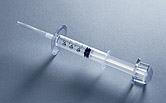
MONDAY, April 2 (HealthDay News) — Cancer patients who receive a combination of low-dose interleukin-2 and retinoic acid after conventional therapy seem to live longer than those who don’t get the combination.
These new study findings, slated for presentation this week at the annual meeting of the American Association for Cancer Research in Chicago, were seen across individuals with many different forms of advanced malignancies, including breast, lung and colon cancers.
Retinoic acid is derived from vitamin A. Interleukin-2, a compound that fortifies the immune system, is approved at high doses to treat “metastatic” melanoma and kidney cancer. Metastatic means that a cancer has spread.
The study showed that “these biological compounds may work at low doses. Bigger doses are not always better,” said lead author Dr. Francesco Recchia, director of the oncology department at Civilian Hospital in Avezzano, Italy.
Recchia stumbled upon the possibility of using low-dose interleukin-2 (IL-2) when he switched a patient with metastatic melanoma who didn’t tolerate high doses to a lower dose, and the patient had an extended response to the therapy.
This study involved 500 patients who had already responded well to chemotherapy. They had a variety of cancers, including ovarian, lung, colon, stomach, kidney, melanoma, breast and pancreatic.
Participants gave themselves the interleukin-retinoic acid duo five days a week for three weeks, then took a break of one week followed by another three weeks — for five years or until the cancer came back.
Individuals who pursued the maintenance therapy did live longer, the researchers found. About 43 percent of breast cancer patients were alive after five years, versus an expected average survival of about only one-quarter of patients.
Similarly, about 26 percent of lung cancer patients were alive after five years versus about 4 percent expected, nearly 44 percent of those with colorectal cancer were alive as compared with about 12 percent in an average population, and 23 percent of kidney cancer patients were alive versus 11 percent expected.
After 15 years, about 33 percent of patients were alive without having had a recurrence and 37 percent overall were alive, the investigators reported.
“This regimen works by increasing immune response,” Recchia explained.
In this case, immune response consisted of an increase in the number of natural killer cells, which are primed to attack tumors, and a decrease in vascular endothelial growth factor, which would normally prompt a tumor to spread.
There were no serious side effects, Recchia said, and the therapy’s cost is about $300 a week.
While IL-2 activates the immune system, retinoic acid is an angiogenic agent, meaning it reduces blood supply to tumors, explained Dr. Michael Atkins, deputy director of the Georgetown Lombardi Comprehensive Cancer Center in Washington, D.C. He was not involved with the study.
The results are “provocative,” Atkins said, but one problem is that all the patients had already benefited from chemotherapy so it’s unclear if they would have done well without the immune therapy, he added.
A bigger trial of patients randomly assigned to receive treatment is now starting in Siena, Italy, in breast cancer patients, Recchia said.
Because this study was presented at a medical meeting, the data and conclusions should be viewed as preliminary until published in a peer-reviewed journal.
More information
For more on interleukin-2 and other biological therapies, visit the U.S. National Cancer Institute.

